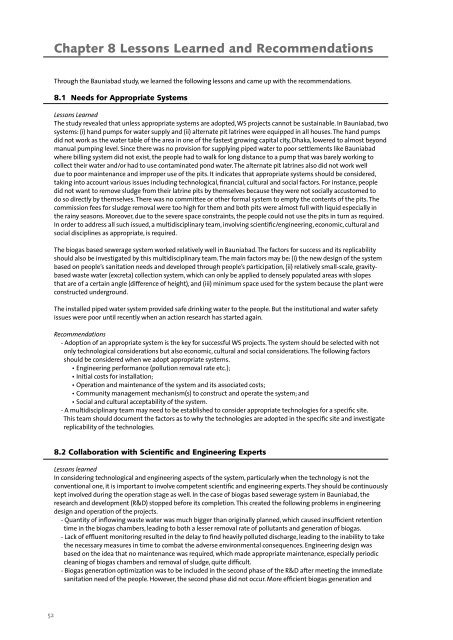Untitled - UNU-IAS - United Nations University
Untitled - UNU-IAS - United Nations University
Untitled - UNU-IAS - United Nations University
Create successful ePaper yourself
Turn your PDF publications into a flip-book with our unique Google optimized e-Paper software.
Chapter 8 Lessons Learned and Recommendations<br />
Through the Bauniabad study, we learned the following lessons and came up with the recommendations.<br />
8.1 Needs for Appropriate Systems<br />
Lessons Learned<br />
The study revealed that unless appropriate systems are adopted, WS projects cannot be sustainable. In Bauniabad, two<br />
systems: (i) hand pumps for water supply and (ii) alternate pit latrines were equipped in all houses. The hand pumps<br />
did not work as the water table of the area in one of the fastest growing capital city, Dhaka, lowered to almost beyond<br />
manual pumping level. Since there was no provision for supplying piped water to poor settlements like Bauniabad<br />
where billing system did not exist, the people had to walk for long distance to a pump that was barely working to<br />
collect their water and/or had to use contaminated pond water. The alternate pit latrines also did not work well<br />
due to poor maintenance and improper use of the pits. It indicates that appropriate systems should be considered,<br />
taking into account various issues including technological, financial, cultural and social factors. For instance, people<br />
did not want to remove sludge from their latrine pits by themselves because they were not socially accustomed to<br />
do so directly by themselves. There was no committee or other formal system to empty the contents of the pits. The<br />
commission fees for sludge removal were too high for them and both pits were almost full with liquid especially in<br />
the rainy seasons. Moreover, due to the severe space constraints, the people could not use the pits in turn as required.<br />
In order to address all such issued, a multidisciplinary team, involving scientific/engineering, economic, cultural and<br />
social disciplines as appropriate, is required.<br />
The biogas based sewerage system worked relatively well in Bauniabad. The factors for success and its replicability<br />
should also be investigated by this multidisciplinary team. The main factors may be: (i) the new design of the system<br />
based on people’s sanitation needs and developed through people’s participation, (ii) relatively small-scale, gravitybased<br />
waste water (excreta) collection system, which can only be applied to densely populated areas with slopes<br />
that are of a certain angle (difference of height), and (iii) minimum space used for the system because the plant were<br />
constructed underground.<br />
The installed piped water system provided safe drinking water to the people. But the institutional and water safety<br />
issues were poor until recently when an action research has started again.<br />
Recommendations<br />
- Adoption of an appropriate system is the key for successful WS projects. The system should be selected with not<br />
only technological considerations but also economic, cultural and social considerations. The following factors<br />
should be considered when we adopt appropriate systems.<br />
• Engineering performance (pollution removal rate etc.);<br />
• Initial costs for installation;<br />
• Operation and maintenance of the system and its associated costs;<br />
• Community management mechanism(s) to construct and operate the system; and<br />
• Social and cultural acceptability of the system.<br />
- A multidisciplinary team may need to be established to consider appropriate technologies for a specific site.<br />
This team should document the factors as to why the technologies are adopted in the specific site and investigate<br />
replicability of the technologies.<br />
8.2 Collaboration with Scientific and Engineering Experts<br />
Lessons learned<br />
In considering technological and engineering aspects of the system, particularly when the technology is not the<br />
conventional one, it is important to involve competent scientific and engineering experts. They should be continuously<br />
kept involved during the operation stage as well. In the case of biogas based sewerage system in Bauniabad, the<br />
research and development (R&D) stopped before its completion. This created the following problems in engineering<br />
design and operation of the projects.<br />
- Quantity of inflowing waste water was much bigger than originally planned, which caused insufficient retention<br />
time in the biogas chambers, leading to both a lesser removal rate of pollutants and generation of biogas.<br />
- Lack of effluent monitoring resulted in the delay to find heavily polluted discharge, leading to the inability to take<br />
the necessary measures in time to combat the adverse environmental consequences. Engineering design was<br />
based on the idea that no maintenance was required, which made appropriate maintenance, especially periodic<br />
cleaning of biogas chambers and removal of sludge, quite difficult.<br />
- Biogas generation optimization was to be included in the second phase of the R&D after meeting the immediate<br />
sanitation need of the people. However, the second phase did not occur. More efficient biogas generation and<br />
52
















